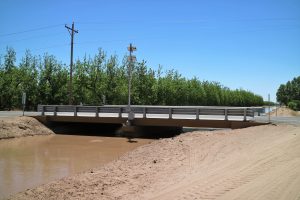The two-lane bridge on NM 186 crossing the La Union Canal in Anthony, New Mexico, may not look any different than other bridges. Yet NM Bridge No. 9706, built this past spring is, in fact, a very unique structure that recently earned New Mexico State University civil engineering Associate Professor Brad Weldon the New Mexico Chapter American Concrete Institute’s 2017 Excellence in Concrete Award.
It is the first bridge superstructure constructed with ultra-high-performance concrete in the state and the first bridge structure in the nation constructed with non-proprietary UHPC consisting primarily of local materials. The bridge design and materials are hoped to increase the lifespan of the bridge and ultimately, reduce the cost to taxpayers.
The bridge is the result of nearly a decade of extensive research conducted by a team of civil engineers from New Mexico State University: Associate Professor Brad Weldon, Professor Craig Newtson and Department Head David Jáuregui, along with numerous student researchers. This ongoing research is a cooperative effort with the New Mexico Department of Transportation and the Federal Highway Administration.
“This is the fun part,” said Weldon, “where the work we do actually gets used.”
It began with experimentation on a new mixture for ultra-high-performance concrete that incorporated fiber reinforcement. An advanced structural material, UHPC is stronger and more durable than conventional concrete and although UHPC is commercially available, it is imported and is expensive, therefore not widely used.
Rigorous optimization of mixture proportions on a small scale in the laboratory showed the concrete’s compressive and flexural strengths were found to be comparable to commercially available pre-packaged UHPC, yielding strengths of 20,000 pounds per square inch and having improved durability properties. Due to these improved properties, the mixture is estimated to have more than twice the structural lifespan of and at half the cost of conventional concrete.
“We tested beams and girders and our investigations showed that the design and behavior of the concrete were effective,” said Weldon, who received a $400,000 grant from the NMDOT last year to continue to investigate the use of the UHPC fiber-reinforced mixture in local precast-prestressed concrete bridge design.
Located along NM 186 crossing the La Union Canal in Anthony, the new bridge replaces a structurally deficient two-span bridge. Designed using the findings of their experimental and analytical program, the new bridge incorporates one span using high-performance concrete typical of that currently used in New Mexico bridge design, and the second span using the localized UHPC. Each girder of the bridge has embedded vibrating wire and/or fiber optic instrumentation to enable continuous data collection. The completed bridge was load tested by NMDOT and NMSU to collect baseline sensor readings. Additional real-time external strain sensors provide supplement data and additional testing will continue over the next several years.
“The sensor instrumentation is connected to data loggers powered by solar panels, for continuous data collection. Later we will run a proof test, loading the structure to determine if the behavior is what we expect it to be,” said Weldon.
“We are looking for new ways to implement the use of UHPC in bridge components with the end goal of extending the service life, reducing maintenance costs and improving our transportation infrastructure.”

